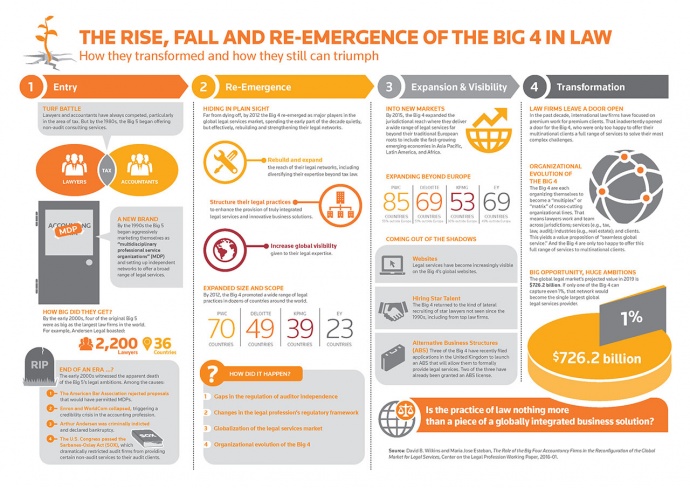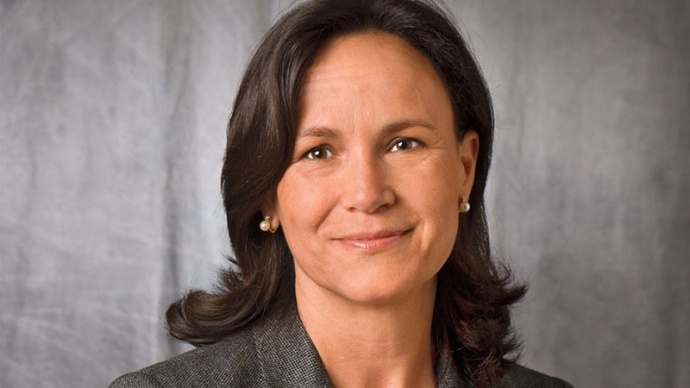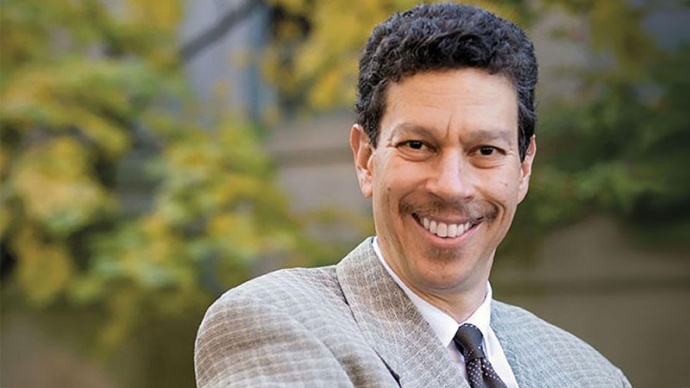It is now common knowledge that the global market for legal services has become increasingly competitive. What is less well-known is that a major source of this competition in the coming years is likely to be an adversary that many lawyers – particularly those in the United States – believed had been banished from the field more than a decade ago. These competitors are commonly known as the Big 4 accounting firms, although in truth they haven’t been primarily “accounting firms” in several decades. Instead, these large, sophisticated and increasingly global firms have been slowly but surely transforming themselves from audit firms, to multidisciplinary professional service firms, to “globally integrated business solution providers” – where an important component of the business solutions that they offer is law.
For the last three years, the Harvard Law School Center on the Legal Profession has been studying this transformation and its likely impact on the global market for legal services. The infographic below summarizes some of the highlights of our research. In this essay, we situate these findings in the context of the broader changes that are happening in the legal marketplace.

We began this research with a puzzle. In the 1990s, the Big 5 (as they were then) began setting up “independent” legal networks that nevertheless operated under the overall umbrella of the accounting firms. The strategy was simple: Look as much like a traditional law firm as possible. By the early 2000s, four of these networks – Andersen Legal, Landwell, KLegal and E&Y Law – were as large as the largest law firms in the world.
Accompanying this growth was a concerted public relations campaign to portray the Big 5 legal networks as just another top firm – only bigger. But after the accounting scandals associated with the bursting of the dot-com bubble, Arthur Andersen was indicted and eventually dissolved and a tidal wave of regulation, such as Sarbanes-Oxley, purported to ban the now Big 4 from delivering non-audit services to their audit clients. As a result, most observers assumed, in the words of a 2003 Economist article, that the “accountancy firms drive in the legal arena is dead.”
Yet, as the infographic demonstrates, far from being “dead,” the Big 4 have spent the last decade quietly rebuilding and strengthening their legal networks to the point where they are now as big or bigger than they were in 2001. More importantly, they have done so in a manner befitting the competitive realities of the 21st century, as opposed to attempting to copy the model still used by many law firms that was created to fit the realities of the 19th. Specifically, our data demonstrates that the Big 4 have quietly managed to:
- Rebuild and expand the reach of their legal networks, including diversifying their practice expertise beyond tax law and their regional coverage beyond Europe to the important emerging economies of Asia Pacific, Latin America, and Africa and the Middle East
- Structure their legal practices through the most highly integrated form of multidisciplinary professional service organizations (MDP) in order to enhance the provision of truly integrated legal services and innovative business solutions
- Increase the global visibility given to their expertise in law
How did this happen? Although the process is complex, as the infographic indicates, we believe that four interrelated factors have allowed the Big 4 to expand their legal offerings notwithstanding the efforts by regulators and bar associations to prevent them from doing so:
- Gaps in the regulation of auditor independence, particularly the failure to restrict selling non-audit services (including legal services) to non-audit clients, who now make up the majority of each of the Big 4’s legal customers
- Changes in the legal profession’s regulatory framework, most notably the UK’s authorization of “Alternative Business Structures,” which expressly permit the kind of multidisciplinary practice championed by the Big 4
- The organizational evolution of the Big 4 and their shift toward a matrix model that combines law with deep industry expertise, sophisticated data analytics and risk management to produce value-based solutions for clients through global teaming and other professional development strategies designed to attract and retain top talent
- Globalization and the attractiveness of the global market for legal services, particularly in the important emerging economies of Asia Pacific, Latin America, and Africa and the Middle East, where the Big 4 have significantly greater presence than even the most global law firms
Significantly, each of these developments appears likely to continue in the coming years, thereby accelerating the growth and importance of the Big 4’s legal networks.
At the same time, while the Big 4 have been moving aggressively into law, law firms have been making their own transformation into spaces traditionally occupied by the Big 4 and other professional service providers. In order to diversify their services and increase top-line revenues, all while responding to growing client demand for lawyers who “understand our business,” many firms have begun touting their ability to integrate law into broader business solutions that are strikingly similar to the claims being made by the Big 4.
Consider, for example, the UK law firm Eversheds, which in 2010 launched a consulting practice called Eversheds Consulting. Although housed inside the firm, the firm’s consulting arm seeks to move Eversheds beyond the traditional practice of law by providing a suite of consulting services in areas like strategy, technology, human resources and financial services regulatory compliance. Indeed, the firm actively recruits and employs nonlawyer professionals – including several from the Big 4 – to sit alongside and work with lawyers on delivering solutions that combine law and other forms of expertise to provide business solutions to global clients. Other large law firms are following suit. For example, in 2014, Mayer Brown launched a consulting arm in Asia, hiring an international trade advisory team. Similarly, in 2015, DLA Piper announced the formation of a new corporate advisory arm, dubbed “Noble Street,” focusing on financing, corporate and M&A activities within the media, entertainment, technology and sports industries.
The verdict is still out on whether these or other similar ventures will be successful in turning law firms into “globally integrated business solution providers” – just as only time will tell whether the Big 4 will succeed in their latest effort to use this new way of understanding law as an effective entrée into the rapidly expanding global market for business-related legal services. And there remain many important questions about the effect that all of these developments are likely to have on fundamental issues of lawyer professionalism, client service and public policy.
What is clear is that both lawyers and clients are increasingly turning to traditional business methods such as unbundling, outsourcing, process management and partnering to reduce the cost of legal services and to increase return that these services deliver to the bottom line – whether of the client or of the entity delivering the legal service. In such a world, the Big 4’s legal networks are likely to be important players, since they have been engaged in these practices far longer, and far more extensively, than any traditional law firm. Lawyers seeking to understand the dynamics of the legal services market in the coming decades therefore ignore the Big 4’s re-emergence in this arena at their peril.
About the authors
 Maria José Esteban is a lecturer at the Department of Law at ESADE-Universitat Ramon Llull, an affiliated researcher at the Harvard Law School Center on the Legal Profession, and co-director of the Center’s Big Four research project. She is also a partner in the Spanish law firm Bufete Escura. Maria José Esteban is a lecturer at the Department of Law at ESADE-Universitat Ramon Llull, an affiliated researcher at the Harvard Law School Center on the Legal Profession, and co-director of the Center’s Big Four research project. She is also a partner in the Spanish law firm Bufete Escura.
|
 Professor David B. WIlkins is the Lester Kissel Professor of Law, Vice Dean for Global Initiatives on the Legal Profession, and Faculty Director of the Center on the Legal Profession at Harvard Law School. Wilkins is also a Fellow of the Harvard University Edmond J. Safra Foundation Center for Ethics, a Senior Research Fellow of the American Bar Foundation, and an International Research Fellow of the Novak Druce Centre for Professional Service Firms at Oxford University’s Saïd Business School. Professor David B. WIlkins is the Lester Kissel Professor of Law, Vice Dean for Global Initiatives on the Legal Profession, and Faculty Director of the Center on the Legal Profession at Harvard Law School. Wilkins is also a Fellow of the Harvard University Edmond J. Safra Foundation Center for Ethics, a Senior Research Fellow of the American Bar Foundation, and an International Research Fellow of the Novak Druce Centre for Professional Service Firms at Oxford University’s Saïd Business School. |
Learn more
To learn more about this research and the re-emergence of the Big 4 in law, read Volume 2, Issue 2 of The Practice.







